원오원아키텍스(ONE O ONE architects) 대표인 건축가 최욱(Choi Wook, 崔旭)은 서양의 건축이도상학적인 반면 한국의 건축은 그것으로 설명되지 않는다고 말한다. 그는 한국적 표현 방식을 건축에 구현하려고 하며, 바로 그 이유 때문에 시각적인 형태 미학에 관심을 두는 대신 경험과 직관을통해 한국 고유의 공간 형식을 꾸준히 탐색한다.
Choi Wook, president of ONE O ONE architects, says that while Western architecture is iconographic, Korean architecture is not. In pursuing something distinctly Korean through his designs, Choi focuses more on experience and intuition than on visual aesthetics.
최욱은 건축물의 시각적인 조형성보다는 공간 구성에 관심을 기울이는 건축가이다. 건물과 대지(垈地)의 관계, 건물 내부와 외부의 소통,질감과 색감 등을 통해 공간 내에서 감성적 체험이 가능하도록 유도한다. Choi Wook pays more attention to spatial composition than visual form. He focuses on the relationship between a building and its surroundings as well as communication between the interior and exterior. ⓒ 텍스처 온 텍스처(texture on texture)“2021년 11월, 국립중앙박물관에 새로 조성된 ‘사유의 방’은 6세기 후반과 7세기 전반에 제작되어 각각 국보 제78호와 국보 제83호로 지정된 두 점의금동미륵보살반가사유상을 위한 공간이다. 어두운 진입로를 돌아 흙빛의 공간에 들어서면 관람객들은 한국인이 사랑하는 미륵의 미소를 만난다.
The Room of Quiet Contemplation was created in November 2021 in the National Museum of Korea to display two gilt-bronze pensive Maitreya bodhisattva statues. Designated as Korea’s National Treasures No. 78 and No. 83, the statues were made in the late sixth and early seventh centuries, respectively. Entering the clay-colored room after passing through a dark corridor reveals the serene smilesof the pensive bodhisattvas, which are beloved by many Koreans.
쇼케이스를 벗어난 국보의 안전성에 대한 고려,360도 관람이라는 과감한 시도, 불상 고유의 의미와 가치를 지키면서도 새로운 전시 방식을 구현한 ‘사유의 방’은 시공간을 초월한 듯한 공간감을 보여 준다. 관람객들이 불상을 접하는 공간의크기는 배우의 표정을 잘 읽을 수 있는 소극장의 내부 길이인 24m로 하고, 두 개의 불상을 어긋나게 배치해 타원형 좌대 위에 올렸다. 1도 정도 기울어진 바닥과 천장은 불상들을 향하고 있으며,벽은 빛을 흡수하는 흙과 숯 같은 자연 재료로 마감했다. 덕분에 내부에서는 금동 불상만이 빛을 뿜는다.
For the design of the room, various aspects were taken into consideration. It boldly offers 360-degree views while ensuring the safety of the national treasures. It also preserves the meaning and value of the Buddhist statues and implements a new exhibition method. In all, the room itself seems to transcend time and space. Measuring 24 meters in length, it offers viewers the opportunity to examine the statues in a space the sizeof a small theater, the type in which audiences can observe actors’ expressions. The two pensive bodhisattva statues are intentionally misaligned on top of an oval platform. The walls are finished with naturally light-absorbing materials, such as clay and charcoal, and the ceiling and floor facing the statues have a one-degree incline. This allows only the gilt-bronze statues to shine in the exhibition room. The ceiling is covered with aluminum rods, designed to give the impression of a vast night sky.
천장은 소방법을 고려해 검고 평활한 면 대신 알루미늄 봉을 선택했다. 빼곡한알루미늄 봉들 덕분에 천장은 광활한 밤하늘이 펼쳐지는 듯한 느낌을 준다. “시각적인 투시화법을 깨뜨리고 싶었어요. 시각적 중심이 없으면 사람들이 자연스럽게 움직이게 되죠. 탑돌이를하듯 말이죠. 엄정한 기하학적 논리보다 영적 분위기를 전달하는 데 초점을 맞추었어요. ” 이 공간을 설계한 건축가 최욱은 서양의 투시도법에서 벗어나 공간의 감각을 구체화하는 접근방법을 보여 줬다.
Describing how he approached this work, architect Choi Wook says, “I wanted to break away from the visual perspective. Without a visual center, people tend to move naturally, like circling around a pagoda when celebrating Buddha’s Birthday. I focused on conveying a spiritual ambience rather than following strict geometrical logic.” In his design, Choi moved away from a Western perspective and demonstrated a new approach to experiencing asense of space.
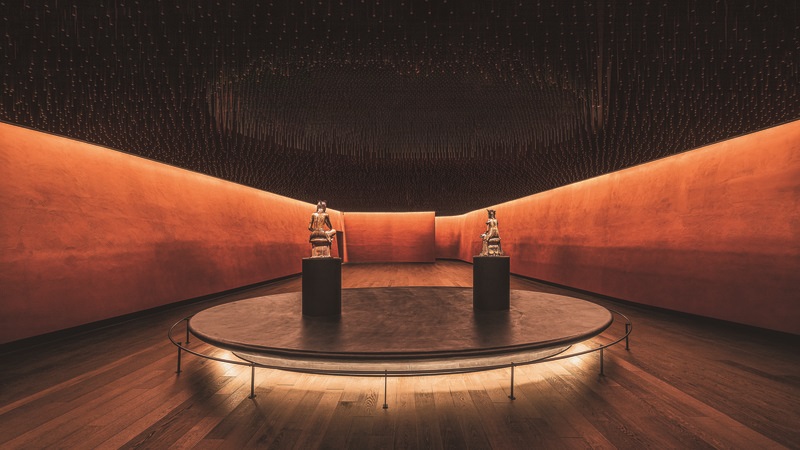
국립중앙박물관의 ‘사유의 방’은 전시 방식에 있어 새로운 전기를 마련한 것으로 평가된다. 유물을 360도로 관람할 수 있게 공간을 조성했으며,유물과 관람객들 간 거리도 치밀히 계산했다. The National Museum of Korea’s Room of Quiet Contemplation opened a newchapter in exhibition methods. The space was created to allow 360-degree viewing of the two pensivebodhisattvas and provide a precise distance between visitors and the exhibit. 원오원아키텍스 제공, 사진 김인철(Kim In-chul, 金仁哲)
한국 건축에 대한 탐색 - SEARCH FOR KOREAN ARCHITECTURE
“베니스 건축대학으로 유학을 갔는데, 당시 유럽에서 주목받는 대학 중 하나였어요. 당대 진보적인 지식인들과 건축계의 석학들이 모여 있었죠. 논리적이고 이성주의에 근거한 서양 건축을 배우다보니 우리와 굉장히 다른 체계를 가지고 있다는 걸 알았어요. 르네상스 시기에 들어서면 투시화법적인 공간이 생기는데, 그러면 파사드가 중요해지거든요. 그런데 한국 건축은 파사드가 중요치않은 것 같았어요. ‘우리는 다른 체계가 있을 것 같다’라는 의구심이 들었죠.”
“I went to study at the University Institute of Architecture of Venice [now Iuav University of Venice], oneof the schools in Europe that was attracting attention at the time for its progressive intellectuals andarchitectural scholars. Studying Western architecture, with its roots in logic and rationalism, made methink that it was based on a very different system from Korean architecture. During the Renaissance, spaceusing the perspectival method emerged, and naturally the façade became important. But Korean architecturedidn’t seem to place too much weight on the façade.”
유학 시절 비첸차의 안드레아 팔라디오 도서관 계단에서 만난 현대 음악가의 질문도 흥미로웠다. “한국의 음악은 정말 이상하지 않냐고 하더라고요. 서양 음악은 서로 교류하며 화음을 만드는데, 우리나라 음악은 5개 음이 질주한대요. 만나질 않는다고요. 나중에 저는 그것을병치의 세계라고 이해했어요. 서양의 컴포지션과 극명하게 다른 거죠.”
While in Italy, Choi was once asked an interesting question by a musician on the steps of the PalladioMuseum; did he consider traditional Korean music to be strange? The musician told Choi that it was hisbelief that Western music built harmony through exchange, while in contrast, Korean music consisted of a5-pitch scale without semitones. “Later, I understood that to be the world of juxtaposition. It’sdramatically different from Western composition.”
한국 건축을 제대로 알아야겠다는 갈증은 유학에서 돌아온 후 건축 답사를 다니면서 조금씩 해소되었다. 그는경사지가 많은 우리 땅에서 자연환경에 순응하며 배치된 기단(基壇)의 존재에 주목했다. 작은 필지가 모여 만드는 군집의 풍경도 매혹적이었다. 도심 개발로 인해 북촌 한옥들이 급격하게 사라져가는 풍경을 목격하고 충격에 빠진 2000년대 초반에는 북촌에 자리한 한옥에 사무실을 꾸렸다. 한옥의 특징을 체험하고 관찰하는 시간이었다. 이러한 탐색의 시간은 곧 결과로 이어졌다.
His thirst to gain a better understanding of Korean architecture was gradually quenched after completing hisstudies abroad, when he returned to Korea and participated in a number of architectural field trips. Hebegan to focus on foundations, which were a means of adapting to Korea’s hilly terrain. Clusters ofsmall plots of land particularly fascinated him. In the early 2000s, he was dismayed to learn that the hanok, or traditional Korean houses, in Seoul’s Bukchonneighborhood were quickly disappearing due to redevelopment. Soon after, he found himself an office in oneof them, which gave him time to experience and observe traditional Korean architecture. His time thereyielded tangible results.
2012년의 현대카드 디자인 라이브러리(Hyundaicard Design Library)와 2016년의 현대카드 쿠킹 라이브러리(Hyundaicard CookingLibrary) 등 현대카드 라이브러리 시리즈에서는 빛과 소리, 냄새 등 공간 자체가 주는 감각에 주목했다. 또한 2013년 작업한 현대카드 영등포 사옥(HyundaicardYeongdeungpo Office Building)의 경우 로비 바닥면을 외부로 확장시켜 건물 안과 밖의 경계가 사라지게 했다. 여러 고층 빌딩에서는 주변 땅의 흐름을 고려한 섬세한저층부가 기단의 역할을 하도록 했고, 상층부는 그 존재감을 없애 파사드의 존재를 흐릿하게 만들고자 했다. 로비에서는 여러 방향에서 빛이 들어와 공간 내부에 그림자가 지지 않는양명(陽明)한 빛을 만들었다. 서양 건축의 체계로 구현되는 현대 건축에서 그는 경험을 통해 체감하는 동양적 접근을 시도한 것이다.
Choi’s contributions to the Hyundai Card Library series, which included the 2012 Design Library andthe 2016 Cooking Library, paid great attention to the sensory experience provided by the light, sound, andsmell in each space. In his work on the Hyundai Card Yeongdeungpo Office Building in 2013, he made theboundary of the building effectively disappear by extending the lobby floor to the exterior. Many ofChoi’s high-rise buildings follow this pattern; the lower floors accommodate the flow of thesurrounding land in order to serve as a foundation, while the upper floors are lightened, rendering thefaçade more subtle. His lobbies invite in light from many directions, creating a bright, warm glow, withoutshadows cast into the space. Into these modern environments, built using Western architectural styles, Choiinserts his Eastern approach, using experience to incorporate sensory elements and feelings.
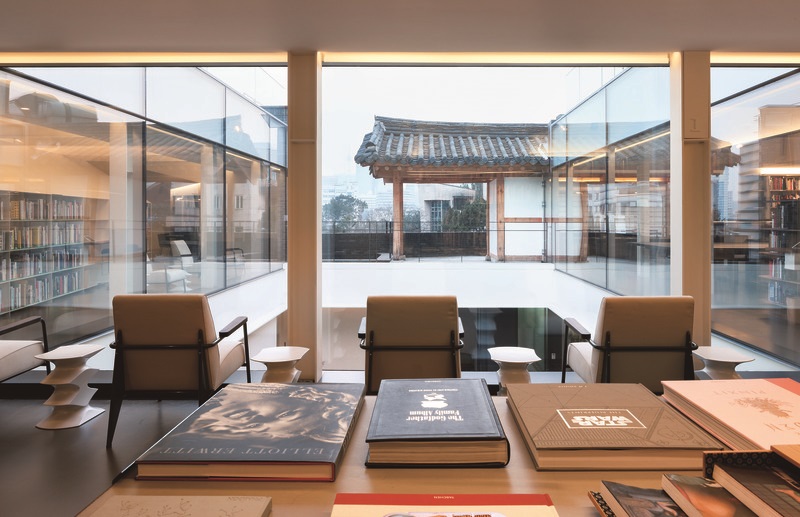
서울 가회동에 위치한 현대카드 디자인 라이브러리는 최욱이 기존 갤러리 건물을 간결하게 레노베이션하여 여백의 아름다움을 살린 공간이다.중정을 둘러싼 삼면에 유리창을 두어 밝은 빛을 실내로 끌어들였고, 나무∙철∙스테인리스 같은 소재를 사용해 각각의 물성을 대비시켰다. Choi Wook renovated the Hyundai Card Design Library from an existing gallery inGahoe-dong to accentuate the beauty of void space. Windows were installed on the three sides surroundingthe courtyard to invite in light and contrasting materials such as wood and stainless steel were used. 원오원아키텍스(ONE O ONEarchitects) 제공, 사진 남궁선
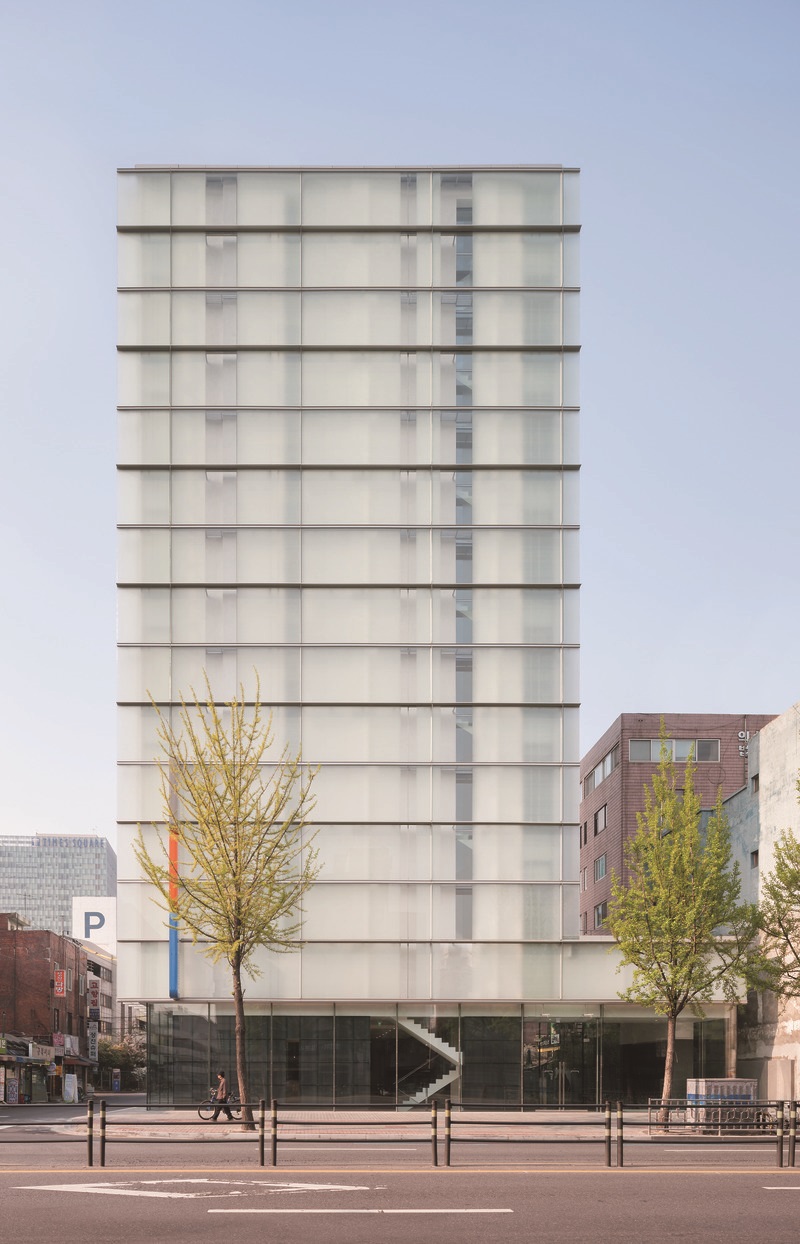
현대카드 영등포 사옥은 건물이 주변 환경에 스며들도록 설계되었다. 1층 로비 바닥을 건물 외부로 확장시켜 안팎의 경계가 사라지게 했으며,건물 외피에 입힌 커튼월은 고층 빌딩의 존재감을 약화시켜 주변 다른 건물들과 위화감 없이 어울리게 만든다. The Hyundai Card Yeongdeungpo Office Building was designed to blend in with thesurrounding environment. The flooring of the lobby was extended to the exterior to diminish the boundarybetween inside and outside, while the building’s curtain wall harmonizes it with the nearbystructures. 원오원아키텍스 제공, 사진 남궁선(Namgoong Sun,南宮先)
공간의 흐름 - FLOW OF SPACE
“우리 전통 건축은 터의 단면과 기단이 공간의 성격과 크기 그리고 사람의 움직임을 만들었어요. 일반적인 이야기처럼 들릴 수도 있겠지만, 우리는 땅과 주변 상황을 먼저 이해하려고 합니다.그리고 건물이 놓이는 대지와 주변의 관계, 즉 단면의 연속적 시퀀스를 만들려고 노력합니다. 바닥의 질감, 공간의 온도와 색감을 맞추는 게 중요한 주제예요.”
“In traditional Korean architecture, the cross section of the ground and the foundation dictate thecharacteristics and size of a space as well as human movement within. It may sound simplistic, but we firsttry to understand the ground and the context. We look at the relationship between the land a building willsit on and the surroundings. In other words, we try to create a continuous sequence of planes. It’svery important to match the texture of the flooring with the temperature and color of thespace.”
화장품 제조 기업아모레퍼시픽의 헤리티지 브랜드 설화수(雪花秀)는 2022년 서울 가회동(嘉會洞)에 플래그십 스토어 ‘설화수의 집’을 열었다. 이곳은 최욱이 추구하는 건축의 접근법을 잘 보여 준다.1930년대 지어진 대로변의 근대 한옥과 1960년대의 양옥을 레노베이션한 이 프로젝트는 시대와 형식이 다른 두 건축물들을 하나로 연결하는 것뿐만 아니라, 여러 채가 군집을 이룰 때공간의 흐름을 어떻게 만들어 낼 것인가가 중요했다.
In 2022, Korean cosmetics brand Amorepacific opened a flagship skincare store and a tea house in ChoiWook’s Gahoe-dong Duzip, located in the eponymous Seoul neighborhood. The building clearlydemonstrates Choi’s approach to architecture. The project involved the renovation of a hanok residencebuilt in the 1930s and a Western-style house from the 1960s. Beyond simply connecting buildings of twodifferent styles and ages, Choi created a flow of space by faithfully reflecting the ground of the existinghanok.
그는 기존 한옥의 터를 충실히 반영하면서 땅의 흐름을 만들고, 전면 한옥의 중정과 뒤편에 길게 들어선 양옥을 잇기 위해6m에 달하는 옹벽을 털어 냈다. 양옥에 지하층을 만들어 한옥의 중정과 연결하는 작업은 매우 까다롭고 어려웠지만, 이를 통해 구조적인 문제를 해결할 수 있었다. 여기에 더해 어떻게 하면한옥의 장점을 극명하게 보여 줄 수 있을까 고민한 결과, 한옥에 투명한 유리문과 창을 설치하고 채와 채 사이 공간에서 시선이 사선으로 흐르도록 했다. 이를 통해 한옥에서 양옥으로 이르는길에서는 각기 다른 풍경을 만나게 된다. 최욱은 이를 일보일경(一步一景)이라고 부른다. 몸의 감각이 경험하는 산책로인 셈이다.
He also got rid of the six-meter retaining wall in order to connect the courtyard of the hanok in theforeground and the Western-style residence in the background via an underground floor. While this waschallenging, it helped solve structural problems. Choi also gave serious thought as to how to maximize the other merits of the hanok’s design.His solution was to install transparent glass doors and windows in the hanok, allowing one’s gaze to flow through the entire open space created by the two properties. Visitors can therefore experience what Choidescribes as “a new view with every step.”
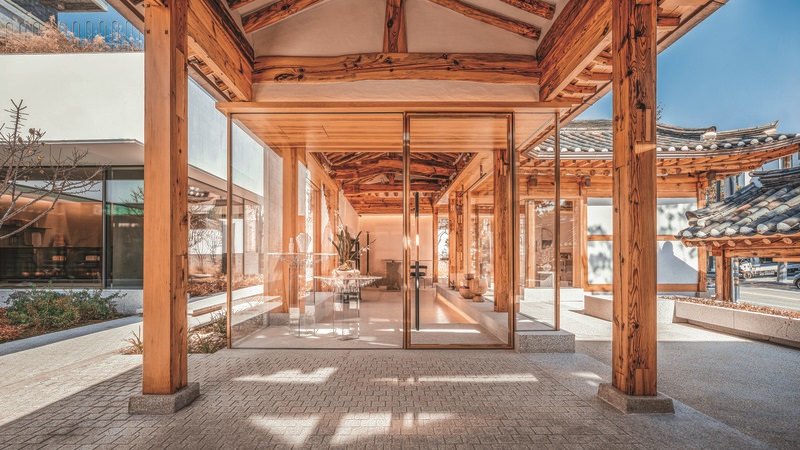
‘설화수의 집’은 한국적인 공간 구현에 대한 건축가의 탐색이 잘 드러난 곳이다. 그는 기존에 있던 한옥과 양옥을 하나의 공간으로 합치기위해 두 집을 가로막고 있던 옹벽을 없애고 그 자리에 중정을 만들어 서로 연결시켰다. Gahoe-dong Duzip (Two Houses in Gahoe-dong) showcases the architect’sinterest in implementing a Korean-style space. In order to combine an existing hanok and a Western-stylebuilding, he removed the retaining wall that stood in the middle and created a courtyard. 원오원아키텍스 제공, 사진 김인철
고유한 DNA - UNIQUE DNA
현대카드의 후원으로 이탈리아 건축 디자인 잡지 『도무스(domus)』의 로컬 에디션인 『도무스 코리아(domus Korea)』를 발행하면서 건축에 대한 최욱의 시각은 점차 구체화되었다.2018년 11월 창간호를 시작으로 2021년 가을호까지 총 12권이 발행된 이 잡지는 그가 오랫동안 탐색했던 한국 건축의 특성을 여러 비평가와 작가, 건축가들과 함께 고민해 보는 좋은기회였다. 그는 이 작업을 통해 땅, 그라운드, 병치, 군집, 공(空)감각(비어 있는 공간에 대한 감각)과 같은 키워드를 길어 냈다.
Choi’s perspective on architecture became more concrete when he published Domus Korea, a regional edition of the Italian architecture anddesign magazine Domus. Between 2018 and 2020, he released a totalof twelve volumes, providing him with an opportunity to contemplate the traits of Korean architecture thathe had long researched. In collaboration with critics, writers, and architects, Choi was able to considerkey concepts such as the land, ground, juxtaposition, clusters, and void.
“이 땅에서 살아온 사람으로서 존중의표현이라고 할 수 있죠. ‘한국’이라는 거창한 개념을 말하려는 것보다는 이 땅의 dna, 고유한 문화에 관심을 두고 그것을 받아들이고 싶어요.”
“The contents of the magazine are an expression of respect coming from the people who have lived in thisland. I’m not interested in discussing a grand concept of Korea; rather, I’m interested inKorea’s cultural DNA. I want to fully embrace it.”
최욱은 땅에 대한 이해에서출발해 그것의 성격을 가장 잘 반영할 수 있는 주제를 건축으로 풀어낸다. 이는 논리적인 체계로 설명되지 않는 경험과 직관의 영역에 속한다. 자칫 모호한 언어로 남을 수도 있는 경험과직관을 그는 구체적인 수치와 정교한 구축 방식으로 구현하고, 공간의 경험을 통해 설득한다. 서울 부암동(付岩洞)에 있는 그의 자택 ‘축대가 있는 집’이나 강원특별자치도 고성군에 위치한‘바닷가의 집’은 그가 만들고자 하는 건축의 성격을 잘 보여 주는 원형에 가깝다. “한국 건축은 터의 조건, 빛의 관계, 쓰임새 등을 해석하면서 만들어졌기 때문에 건물의정면이 아닌 공간의 분위기가 중요해요.’라는 그의 말처럼 이 집들은 건축의 외형적 형태가 극대화되는 대신 채와 채 사이의 공간이나 햇빛과 바람, 새소리, 파도 소리 같은 주변 감각이 먼저다가온다.
Choi’s work is characterized by its reliance on experience and intuition rather than logic. Heimplements these seemingly ambiguous terms in detailed measurements and elaborate construction. His currenthome, the House with Chukdae in Buamdong, and the Seaside House in Goseong County are near-perfect examplesof the type of buildings that Choi wishes to create.“Korean architecture interprets the conditions of the ground, the relationship with light, and the usage ofthe building. It’s not the façade but the ambience of the space that is important.” True to thesewords, both the House with Chukdae and the Seaside House do not maximize the exterior form of architecturebut generate a sensory experience from the spaces within, and from other elements, such as the sun, wind,waves, and birdsong.
“국립현대미술관 과천을 설계한 김태수(Tai Soo Kim, 金泰修) 선생님이 오래전 이런 말씀을 하셨어요. 이제 거장의 시대가 끝나고 모더니즘 시대가되었다지만, 1980년대는 모더니즘은 끝났고 오토 파운데이션의 시대라고요. 각자 자신의 토대를 만드는 시대라는 거죠. 제게도 어린 시절의 고유한 기억들이 남아 있어요. 원오원 식구들에게도취향보다는 자신만의 중요한 기억, 개인적인 경험이 굉장히 중요하다고 말해요. 자기 서사를 통해 작업을 읽고 만들어 가는 거죠.”
“Tai Soo Kim, who designed the National Museum of Modern and Contemporary Art Gwacheon, once said thatalthough people talked about modernism as the end of the age of masters, modernism too ended in the 1980s,when individualism took center stage in architecture. Each person draws on their own background, creatingtheir own foundation. I always tell my colleagues at ONE O ONE architects that memories and personalexperience are far more important than taste. You create and interpret work through your own narrative.”
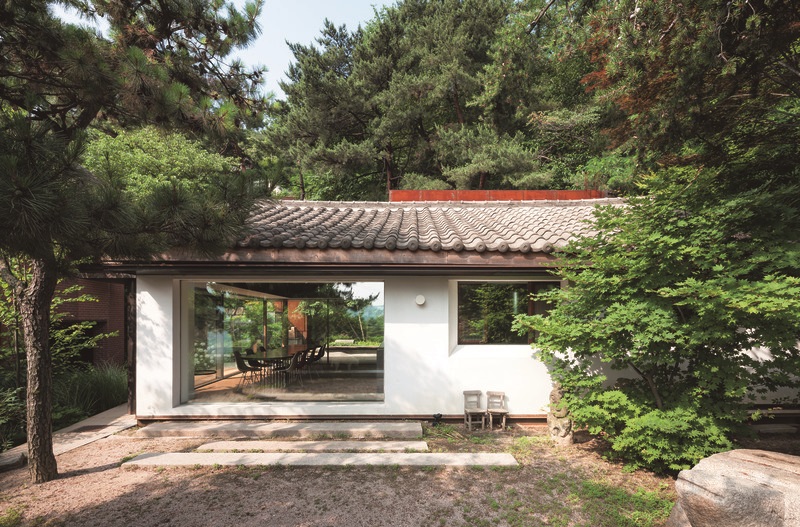
서울 부암동에 위치한 최욱의 자택 ‘축대가 있는 집’은 그가 지향하는 건축이 무엇인지 잘 보여 준다. 지형을 그대로 살려서 지은 이 집은벽을 최소화해 계절의 변화를 오롯이 느낄 수 있다. 사진은 부부가 사용하는 다이닝 공간이다. The House with Chukdae, where Choi Wook lives, is a perfect example of his brand of architecture. The house leverages the topography of the site, while walls are minimized allowing the change of seasons to be experienced more fully. The photo shows the dining space used by Choi and his wife Jinnie Seo, an installation artist. 원오원아키텍스 제공, 사진 남궁선
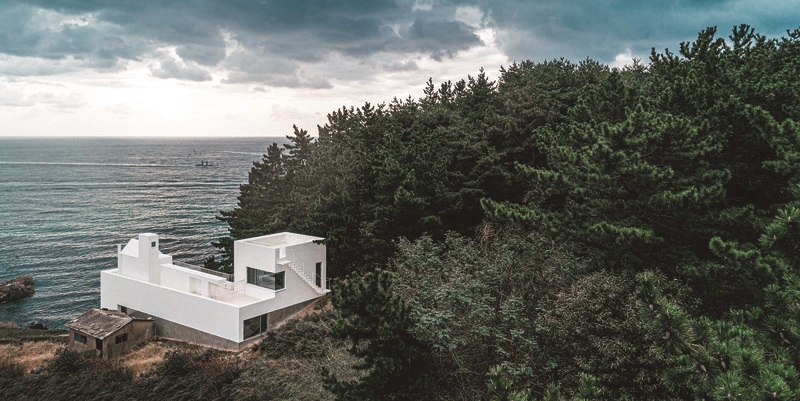
최욱의 세컨드 하우스인 ‘바닷가의 집’은 이 건물이 자리 잡고 있는 어촌 마을의 다른 집들과 이질감 없이 융화될 수 있도록 아담한 크기로지어졌으며, 건물 벽면도 미장으로 마무리되었다. 기능적 고려보다는 곳곳에 창을 크게 내서 바다 풍경을 실내로 끌어들이는 데 중점을 둔 집이다. The Seaside House, which serves as Choi Wook’s second residence, was built modestly so that it would blend in with the humble fishing village where it is located. Its walls were finished with plaster. Less attention was paid to functional aspects, and many large windows were installed to bring the seascape into the house. 원오원아키텍스 제공, 사진김인철
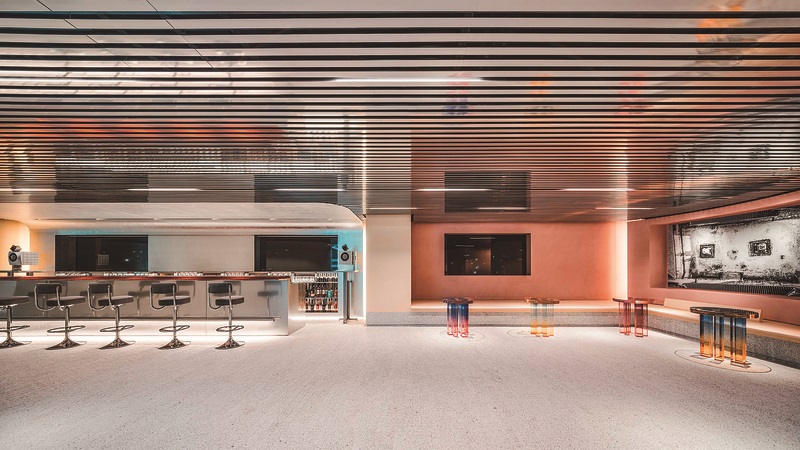
서울 호텔신라 5층에 자리한 현대자동차의 제네시스 라운지(GENESIS Lounge)는 한옥 마당과 대청에서 얻은 모티브를 구현한공간이다. 층고가 낮은 호텔의 실내 공간이라는 제약을 극복하기 위해 천장에는 반사 성질이 있는 재료를 사용했다. Hyundai Motors’ GENESIS Lounge located on the 5th floor of the Shilla Seoul was inspired by madang (courtyard) and daecheong (main hall) of traditional Korean houses. To make up for the low ceiling in the interior space, reflective materials were used on the ceiling to give a sense of height. 원오원아키텍스 제공, 사진 김인철
임진영(Lim Jin-young, 任鎭咏) 오픈하우스서울(OPENHOUSE Seoul) 대표
Lim Jin-young CEO, OPENHOUSE SEOUL




.jpg)





0 comments: